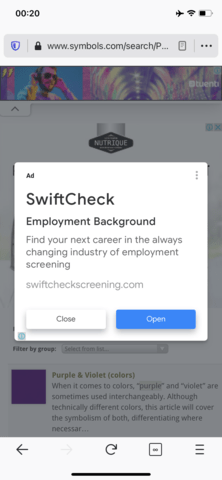So the other day I was going through a website and ran into the next Ad:

Avoiding my usual annoying overthinking and analysis of Ads, at first sight, this looks completely fine, doesn’t it? Except it has a huge trap for the inexpert-in-advertising eye. My first impulse when seeing this Ad is to just go click the “Close” button, but wait, is this the right way to go? No, it’s not. Ads are just images that lead you to websites when you click on them, so what will happen when I click on the “Close” button? Exactly, not close anything and take me to this Ad’s website instead. This, my friends, is what we call a (very) misleading Ad, and here are some thoughts on it.
Whenever we are running a campaign for a client, they are usually worried mainly about three things: The cost (usually on either a CPC or CPM basis), the CTR and their conversions (sometimes their conversion rate, sometimes their cost per conversion, or sometimes other metrics like the view-through conversions). So today we’ll be seeing how this type of Ad will affect these two concerns and how we should explain it to our clients.
So our first thought about this Ad, if we are not very involved in the Display Ad world, could be: “Clever way to make people go to your site even if they didn’t mean to!”. Well yes, it’s a clever way to do that, but what’s the use of it? If 1000 people click on your Ad accidentally, probably 999 of them will leave just as fast as they got there because they are really not interested. Of course, there’s a slight chance that someone actually happened to get interested once they got to your site, but that won’t be the majority of the cases and you must explain this to your clients so they don’t expect something different to happen.
Given this situation, you need to have your clients understand that the CTR number here can (and will) be highly misleading. Even if a lot of people are clicking on your Ad and it seems that you have a great CTR, this probably will not be translated in conversions. No matter how many people get to your website, if they do it by accident and are not actually interested in your products, they will not be useful nor increase the results that you are looking for. This is why it’s so important that your client comprehend that, if they choose to go with an Ad like this one, they need to leave the CTR measure at a lower priority level.
On a second point about this subject, let’s talk about the CPC VS CPM ways of paying for this kind of Display Ad. If people clicking on your Ad doesn’t translate into conversions, what’s the use of paying per click? Maybe you end up paying for 1000 clicks and just one of them turns out to be an interested client. This is information that’s important your client is aware of in order to give them the best possible product. When working with these kinds of Ads, it’s better to go for a CPM payment form for two reasons:
- The more people you show it to, the more interested targets you can reach.
- If you are trying to get random people to accidentally click on your ad, the more people you get to click, the more might be interested once they are on the website.
If your client’s top interest is getting conversions (which it probably will be), there’s really no use in leading a bunch of random people who are not going to convert to their website. Even if there’s a very slight possibility that they get interested in the product when they get there, let’s face it, that’s the least likely thing to happen. So basically if you don’t want your client seeing that they have a huge amount of people going to their websites and only a small portion of them actually converting, don’t go for this strategy.
We could say these hoax-ish kinds of Ads have, like everything, their strong and their weak points, and choosing them or not really depends on what your clients want. If your client is advertising something super rare that’s targeted for a very specific group of people, it probably won’t help their campaign to have a bunch of random people accidentally going to their websites. In this case, it will be very important who you’ll be showing this Ad to. But even when considering that, maybe this kind of Display Ad won’t be our best fit and we might want to go with a more personalized kind of Ad.
On the other hand, if we are running an Ad for a massive product that usually has very wide audiences, this will be a good option to go to. If we are counting on people clicking on it by accident when trying to close it, there’s a much larger possibility of them getting interested if the product we are offering is not a very exclusive one.
Another very important fact to consider is how do you think this type of Ad will look to users? Personally, I’d find it super cheesy and annoying, not to say particularly similar to a scam. Brand images really matter when trying to get conversions on your websites or even just for having a positive opinion on you, and you are for sure not getting that from an Ad that says “close” and does the opposite thing.
Finally, to make the last point for the day: It’s really important that you stop to consider how Google feels about bounce rates. If someone goes to your site and leaves immediately and for good, how do you think that will look to Google’s eyes? Yes, really really sketchy. Having such a misleading Ad will make your bounce rate scale to very high numbers, making it way too hard for Google to see you just as any other site with normal bounce rates.
So, taking all of these facts into consideration, my conclusion here is pretty simple: misleading Ads aren’t good or bad in themselves but must be analyzed in their own contexts. There will be products and clients whose requirements won’t be suited by an Ad that’ll get its biggest amount of clicks by accident, and there will be clients who will find this kind of Ad to be a fantastic way of getting people to their sites. All of the cases have grey areas and all of them should be properly thought through in order to get your clients the highest profit (maybe excluding the CTR number) possible.






